This Livestream Shopping Report is brought to you by our partner, the Influencer Marketing Factory. The report takes an in-depth look at the evolution of Livestream Shopping in the US and UK. Livestream shopping bonanza has been happening in China for a few years now. In 2021, the Chinese livestream market reached almost $317B, so it was obvious that this would be the model for the US market. The Influencer Marketing Factory conducted a survey and collected data from more than 2,000 participants. This Livestream Shopping Report shows the results of the research survey.
Livestream shopping has fallen short of expectations in terms of traction this year. The USA and Europe are still missing certain critical factors such as quality Livestream shopping hosts, interaction and incentives, significant discounts, and many more that make live shopping a unique model. With that being said, this doesn’t mean that it doesn’t have the potential to grow exponentially and this can ideally be a great opportunity for brands, platforms, and creators to beat competitors to the punch and therefore become the market leaders for the upcoming years.
DOWNLOAD THE LIVESTREAM SHOPPING REPORT
Livestream Shopping Report by The Influencer Marketing Factory:
- What is Livestream Shopping?
- Market Size
- The Chinese Market
- A Real Bussiness For KOL'S
- How to Leverage Livestream Shopping Activities
- Live Stream Apps in China
- Methods in which viewers can be engaged or express their satisfaction via Livestream commerce
- We conducted an exclusive survey
- Our Exclusive Livestream Shopping Survey
What is Livestream Shopping?
Livestream shopping is a channel that brands and retailers leverage to promote and sell their products live. It usually combines entertainment and shopping, empowering human connections through social media or live-streaming platforms.
It’s like QVC, but utilized on your phone or laptop. Livestream events are usually hosted by an influencer, a KOL, or a celebrity. Also known as live commerce or live video shopping, purchasing products via online streams is becoming more popular worldwide.
More specifically, in the US and the UK, this phenomenon is relatively new, but in comparison, the Livestream trend is taking off more slowly than in countries like China.
Market Size
In 2022, the Livestream shopping revenue in the US is expected to hit $20 billion and by 2022, the e-commerce revenue created from live online shopping is expected to grow more than 5X and reach more than $60 billion in revenue.
The Chinese Market
Shopping-related content is one of the most popular types among live streaming watchers in China. In fact, Chinese sales are expected to reach $423 billion by 2022. Taobao is the world’s biggest player with a market share of 35%, the conversion rate of the content on Taobao Live is 32%.
With an annual growth rate of 14%, in 2021, 700 million Chinese users watched live stream. Among the 700 Livestream lovers, 460 million have purchased goods via Livestream, accounting for 44.9% of Chinese Netizens.
Unlike the live-streaming platforms in the West, China has revolutionized how e-commerce businesses operate. For instance, in May 2016, Alibaba changed the next wave of e-commerce by introducing Taobao Live. With Livestream, China has enabled a large portion of family- owned businesses and farmers to boom during the pandemic.
A Real Bussiness For KOL'S
Chinese hosts can earn thousands of dollars with virtual gifts, brand deals and commissions on sales. One of the most famous KOLs (Key Opinion Leader) Austin Li - also known as “Lipstick King” sold $1.7 B worth of goods in a 12-hour Livestream for Alibaba’s Singles Day.
In China’s culture, during the Han Dynasty, “rewards” were a source of income for most authors, artists, and performers. Rewarding these artists is an indicator of a high societal position, so therefore the gifting features that we have today among live streams resemble this ancient tradition.
To understand the popularity of live-streaming in China it is worth noting that studies have found that besides the purpose of entertainment and social contact, for viewers in Tier 1 cities (11%), Livestream is a way to escape loneliness, for viewers in Tier 2 (34%) and Tier 3 (55%), Livestream is a window for unseen experiences.
How to Leverage Livestream Shopping Activities
Hosts in the US are typically celebrities or influencers (Chinese equivalent to KOLs). A charismatic host is necessary to start and keep a live running over time and engaging. It’s important to be able to interact and entertain customers, answer questions, and provide accurate information about the products being sold.
In China, hosts don’t only display products, but also unbox them as well as try them on within the live. Being an effective influencer doesn’t always necessarily translate to being a good seller in a Livestream, the skills needed are different.
Livestream directs the consumer directly to the products in order to buy them. Because of the endowment effect, individuals may value an owned object higher than its market value, therefore customers would never want to miss a good deal. A bundle sale is an example of a great deal that consumers cannot stand to miss out on.
Live Stream Apps in China
Taobao Live
Taobao was the first Livestream shopping platform introduced in 2016. The live streaming service offers different categories to shop from such as lifestyle, beauty, food, and fashion. In 2021 the app has accumulated over 50 billion views and the average viewing time increased by 25.8%. The annual number of transactions has increased at a rate of 16.6%. Taobao Live’s audience is 71% female, and 72% of overall users are between 18-34 years old.
Kuaishou
Over 85% of Kuaishou users’ are from rural areas and lower-tier cities. The company introduced live-streaming in 2019 giving smaller users more exposure and lowering the fee compared to other platforms. This resulted in rapid growth and Kuaishou is now the second-largest live-streaming e-commerce platform by GMV. In the second quarter of 2022, the revenue from live streaming increased by 19.1%, contributing to 39.5% to the overall total revenues.
Douyin (Chinese TikTok)
Douyin Livestream feature is popular among young consumers. In fact, as of February 2022, 88.3% of its users reported having live-streamed. Lancôme hosted 40 sessions between May 4 to 25 in collaboration with 20 influencers. Douyin Livestreams over 9 million sessions per month with a gross merchandise value (GMV) that is growing 3.2 times YoY. Orders from Livestream increased 11.2% compared to April 2021.
Methods in which viewers can be engaged or express their satisfaction via Livestream commerce
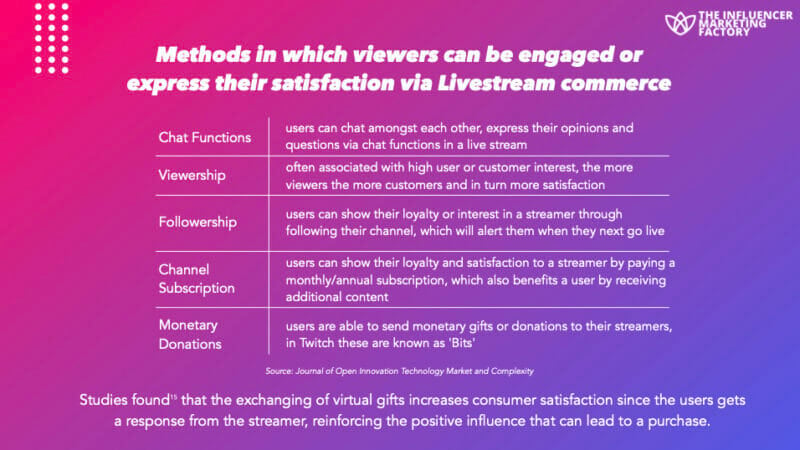
We conducted an exclusive survey
The survey data presented in this report was collected from 1,000 respondents based in the US and 1,000 based in the UK who submitted their responses between October 11, 2022 and October 21, 2022. Our target audience was users between 18 and 67 years old.
Our goal was to understand their preferences in terms of Livestream shopping, social commerce live shopping behavior, Livestream shopping approach, and overall if and how they shop during a Livestream.
Since the UK had seen traction with Livestream shopping in the past year (contrary to other countries in the European zone) we wanted to know more about their consumers. The two countries surveyed should not be looked at as a comparison, but rather as an investigation of the two markets. Western market with more Livestream features, platforms, and brand adaptation.
Our Exclusive Livestream Shopping Survey
After analyzing its results, The Influencer Marketing Factory narrowed down six main findings, which include:
- In the U.S., 36% of our study participants confirmed purchasing something during a livestream shopping event, while 25% of our UK respondents confirmed the same.
- The preferred platforms for Livestream shopping in order of preference for the U.S.: Facebook Live 26%, Instagram Live 19%, TikTok Live 18%, Amazon Live 18%, Pinterest 6%, Others 4%, Whatnot 3%, ShopShops 3%, TalkShopLive 2%, Bambuber 1%.
- The preferred platforms for livestream shopping in order of preference for the UK: TikTok Live 30%, Amazon Live 18%, Facebook Live 17%, Instagram Live 16%, Pinterest 6%, Others 4%, Whatnot 2%, TalkShopLive 3%, NTWK 2%, ShopShops 2%.
- “Quality of product” was the top reason for livestream shopping for respondents both in the U.S. and the UK. Free delivery came in second, discount coupons came in third, and being able to see reviews from other shoppers in real-time came in fourth for both the U.S. and UK respondents.
- A portion of US responders (27%) has spent between $20 and $50 on livestream shopping in the last three months. Comparatively in the UK (31%) of responders have spent between $10 and $20.
- Livestream shopping is not considered “more fun” or “more entertaining” than regular online shopping.
Have you ever purchased something during a livestream?
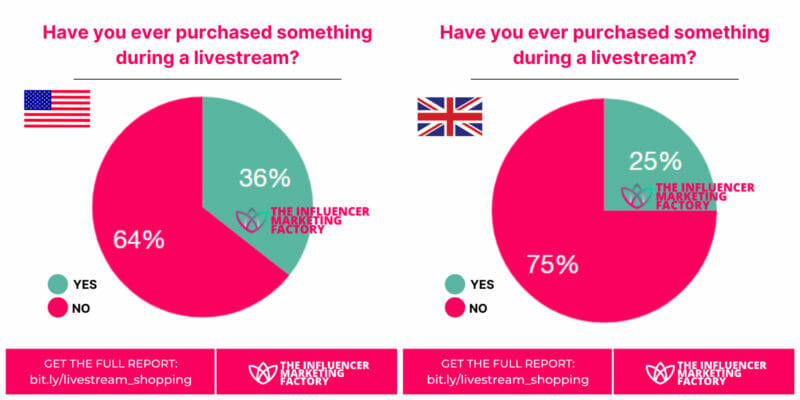
Have you ever purchased something during a livestream? Split by age

How much money have you spent on livestream shopping in the last three months?
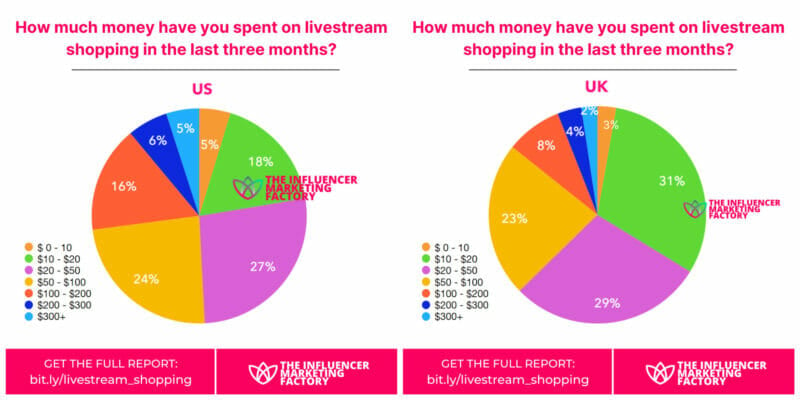
Which platform do you prefer to shop on via livestream?
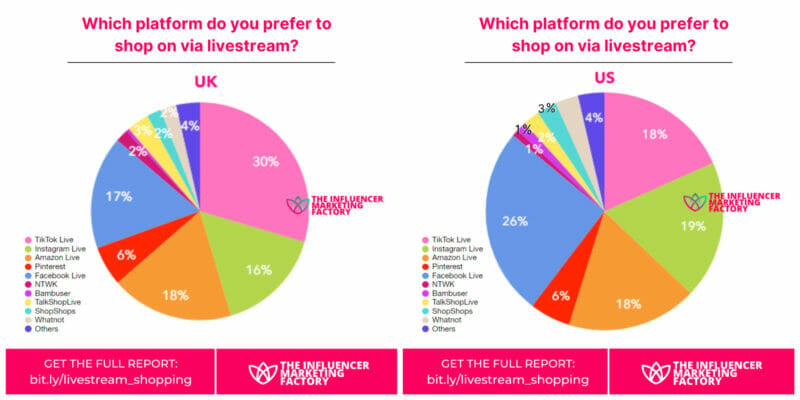
How likely are you going to buy something via livestream in the next 6 months?
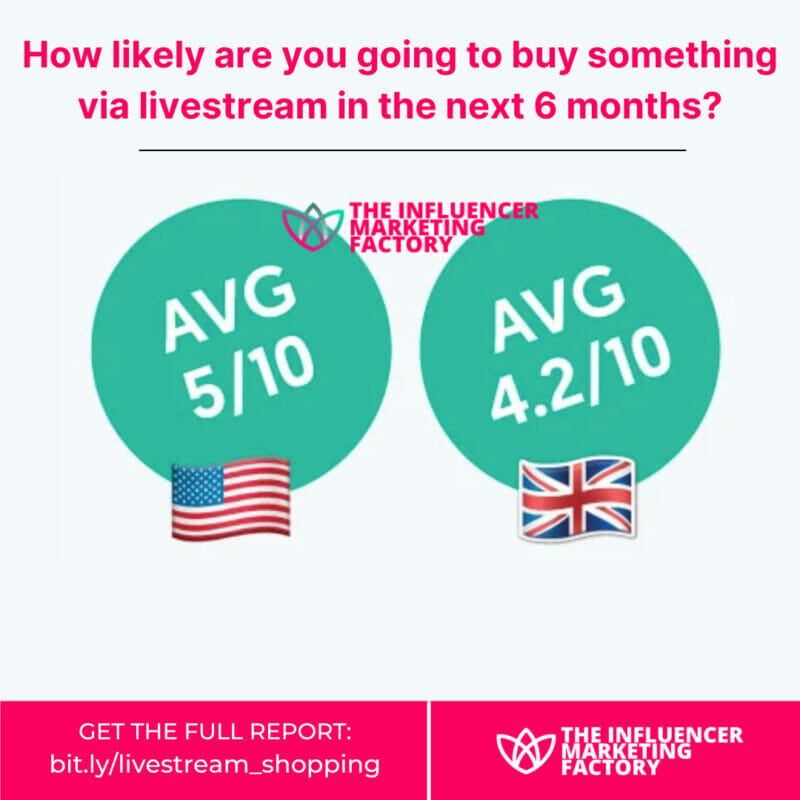
From 1 to 10: "I find livestream shopping more fun and entertaining than regular online shopping."

From 1 to 10: "If I consider the streamer/host/influencer credible, I am more likely to make a purchase."

From 1 to 10: "I prefer livestream shopping because of the interaction I can have with the hosts and other shoppers."

What type of product did you buy during a livestream?

Reasons why someone shops during a livestream (US & UK)

Why do you usually join a livestream shopping event?



